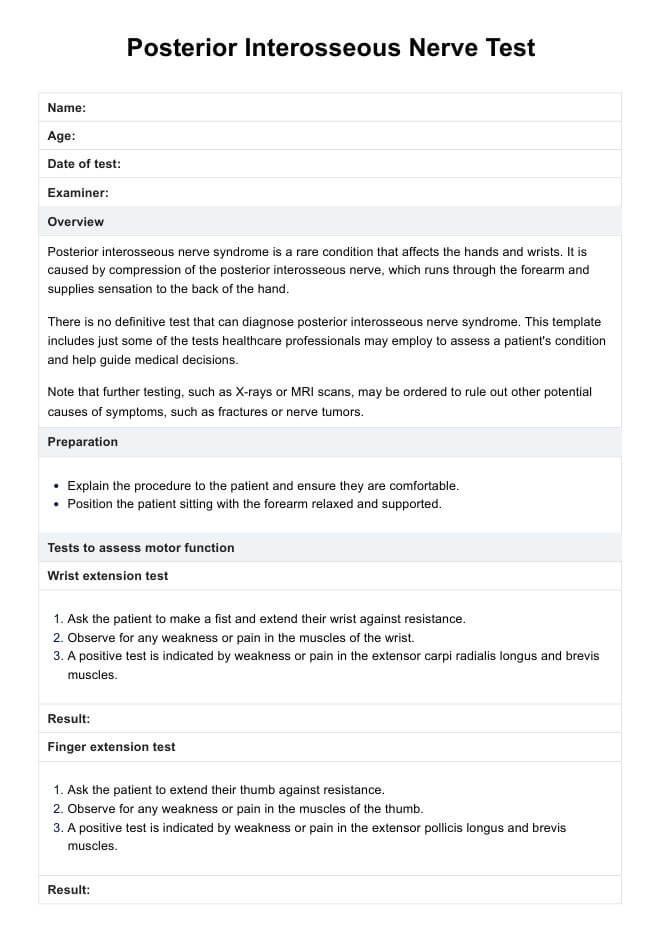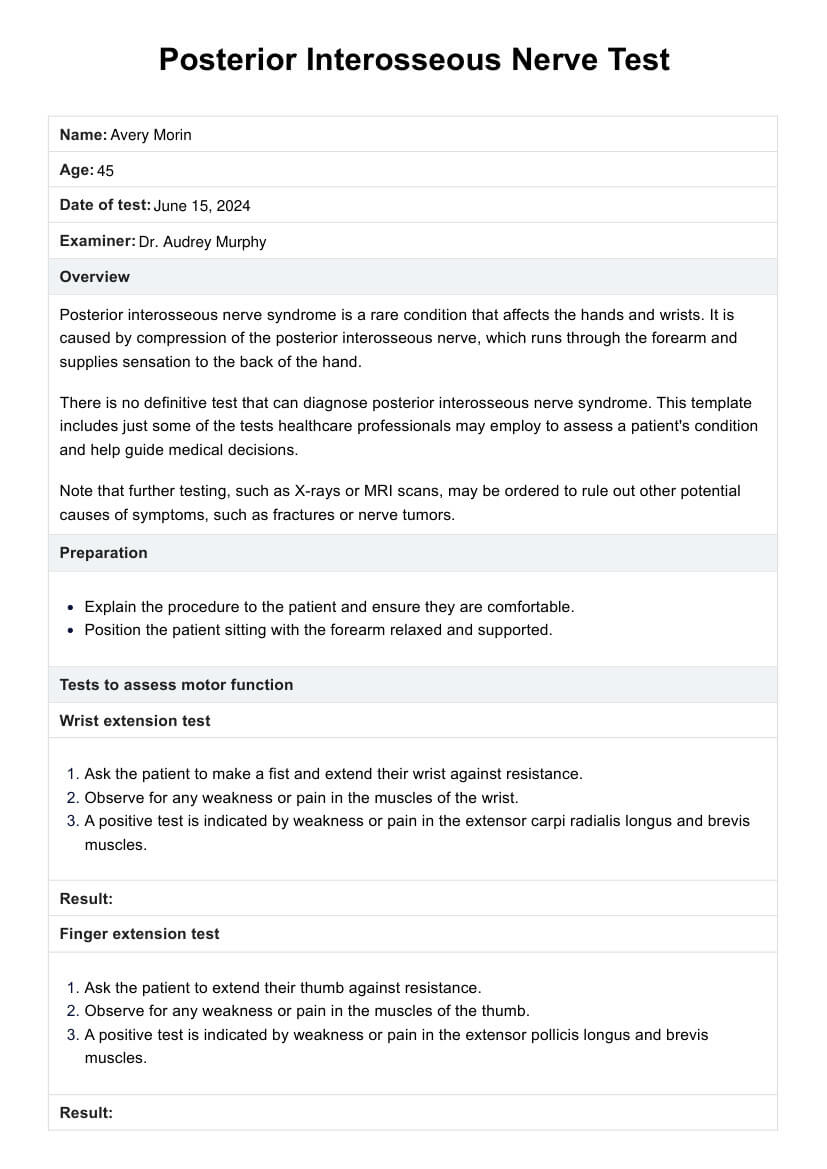Posterior Interosseous Nerve Test
Learn about posterior interosseous nerve tests and examples with Carepatron's free PDF download. Understand the importance of these tests for diagnosis and treatment.


What is posterior interosseous nerve syndrome?
Posterior interosseous nerve syndrome (PINS), also known as posterior interosseous nerve palsy, is a rare condition affecting the posterior interosseous nerve, a branch of the deep radial nerve within the forearm. This syndrome typically results from uncommon nerve compression syndromes or entrapment of the posterior interosseous nerve as it passes through the radial tunnel, situated deep in the upper extremity near the lateral epicondyle of the humerus.
Clinical presentation often includes symptoms such as weakness and pain, particularly around the lateral elbow and forearm. Patients may experience difficulties with fine motor skills and weakness in extension of the wrist and fingers, distinguishing it from more common conditions like lateral epicondylitis.
Diagnosis involves a thorough clinical examination, often with tests to assess motor function and sensitivity in the affected area. Differential diagnosis is crucial to distinguish PINS from other nerve entrapment syndromes such as radial tunnel syndrome, which affects the superficial radial nerve and radial tunnel, and conditions causing lateral elbow pain.
Early recognition and appropriate management are essential to prevent long-term complications and optimize outcomes for individuals affected by posterior interosseous nerve entrapment. Treatment may range from conservative measures such as rest and physical therapy to surgical intervention in severe or refractory cases, aiming to alleviate pressure on the nerve and restore function.
Posterior Interosseous Nerve Test Template
Posterior Interosseous Nerve Test Sample
Diagnosing and testing for posterior interosseous nerve syndrome
Diagnosing posterior interosseous nerve syndrome involves a systematic approach to assess symptoms, perform clinical examinations, and conduct specific tests to confirm the condition and differentiate it from other similar syndromes.
Clinical examination
During the initial assessment, healthcare practitioners should evaluate the patient's medical history, focusing on symptoms such as weakness in wrist and finger extensors, pain around the lateral elbow, and any history of trauma or repetitive use injuries. A thorough physical examination follows, including palpation of the radial tunnel to check for tenderness and observing the range of motion and strength in affected muscle nerve.
Differential diagnosis
It is crucial to differentiate posterior interosseous nerve syndrome from conditions like radial tunnel syndrome and lateral epicondylitis, which also manifest with similar symptoms. Specific tests, such as resisted finger and thumb extension or the Cozen's test for lateral epicondylitis, help in narrowing down the diagnosis.
Nerve conduction studies and electromyography (EMG)
Electrodiagnostic tests like nerve conduction studies and EMG are instrumental in confirming nerve dysfunction and assessing the extent of impairment in the posterior interosseous nerve. These tests measure the electrical activity and speed of nerve signals, providing objective data to support the clinical findings.
Imaging studies
In some cases, imaging studies such as MRI or ultrasound may be employed to visualize anatomical structures and identify potential causes of nerve compression or entrapment within the superficial radial nerve.
Results and interpretations of the tests
Interpreting the results of the posterior interosseous nerve test involves understanding the implications of both positive and negative outcomes. A positive test typically indicates dysfunction or compression of the posterior interosseous nerve, characterized by weakness in specific movements such as wrist extension and radial deviation. This finding suggests potential nerve entrapment syndromes like radial tunnel syndrome or, in severe cases, necessitates surgical decompression to alleviate pressure on the nerve in the proximal forearm.
Conversely, a negative test result suggests intact function of the posterior interosseous nerve, ruling out significant peripheral nervous system impairments or acute injuries such as radial fractures near the radial head. Clinicians should interpret these results in conjunction with clinical findings and imaging studies to formulate an accurate diagnosis and appropriate treatment plan tailored to the patient's specific condition and needs.
How can the template benefit healthcare professionals?
Carepatron's template offers several advantages for healthcare professionals managing cases involving the posterior interosseous nerve. Here are five key benefits:
Comprehensive patient documentation
The template facilitates thorough documentation of clinical assessments, including motor and sensory evaluations related to posterior interosseous nerve paralysis. It ensures all pertinent details are recorded systematically, aiding in accurate diagnosis and treatment planning.
Structured diagnostic workflow
Healthcare providers benefit from a structured workflow that guides them through the diagnostic process for conditions such as pin compression syndrome and radial nerve entrapment. The template prompts clinicians to perform specific tests and assessments, ensuring comprehensive evaluation of extensor muscles and wrist extension capabilities.
Clear patient communication
Enhanced patient education is facilitated through the template's clear visual aids and patient-friendly language. It helps healthcare professionals explain complex concepts like dorsal wrist capsule anatomy and radial recurrent vessels involvement, fostering better patient understanding and compliance with treatment plans.
Integration of diagnostic findings
Carepatron's template allows for seamless integration of diagnostic findings, such as those from electromyography and nerve conduction studies. This integration supports evidence-based decision-making for interventions like surgical exploration of the proximal edge or release of the abductor pollicis longus.
Long-term monitoring and outcome tracking
The template supports longitudinal care by enabling healthcare professionals to monitor treatment progress and track outcomes over time. This functionality is crucial for assessing the efficacy of interventions like surgical decompression near the radial head and adjusting treatment plans as needed.
Commonly asked questions
To check the posterior interosseous nerve, perform specific clinical tests such as resisted middle finger extension or wrist extension against resistance. These maneuvers help assess the nerve's function and identify potential impairments.
Symptoms of posterior interosseous nerve injury include weakness in wrist and finger extension, difficulty with fine motor tasks, and pain around the lateral elbow and forearm.
The posterior interosseous nerve primarily innervates the extensor muscles of the forearm, including those responsible for wrist and finger extension. It plays a crucial role in motor function within the upper extremity.
Damage to the posterior interosseous nerve can lead to weakness or paralysis of the extensor muscles of the forearm, affecting functions such as wrist extension and finger movement. Treatment may involve conservative measures or surgical intervention depending on the severity of the injury.







































































































